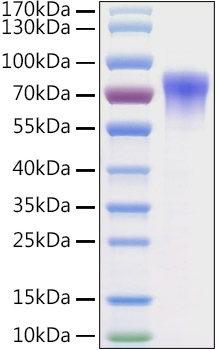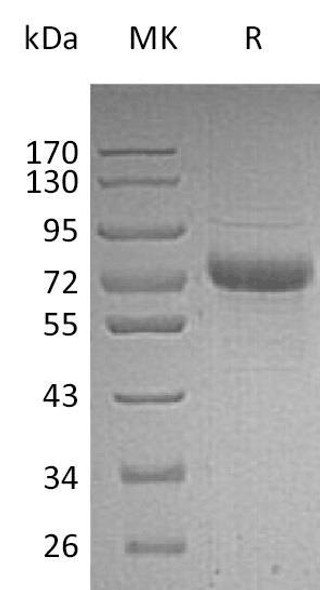Description
Recombinant Mouse Vitronectin/V75/VTN Protein
The Recombinant Mouse Vitronectin/V75/VTN Protein is a high-quality recombinant protein designed for murine biological research applications. This protein serves as an essential reagent in mouse model studies, comparative immunology research, and preclinical therapeutic evaluations, enabling scientists to investigate Vitronectin/V75/VTN biology and its relevance to human disease mechanisms through translational research approaches.
This product (SKU: RPCB1843) is produced using HEK293 Cells and features a C-His tag for convenient detection and purification. The protein exhibits a calculated molecular weight of 53.59 kDa with an observed molecular weight of 75-85 kDa under denaturing conditions, achieving ≥ 85 % as determined by SDS-PAGE.. Functional bioactivity has been validated through rigorous quality control assays, confirming its suitability for demanding research applications.
Key Features
| High Purity by Affinity Chromatography | |
| Mammalian & Bacterial Expression Systems | |
| High lot-to-lot consistency via strict QC |
| Product Name: | Recombinant Mouse Vitronectin/V75/VTN Protein |
| SKU: | RPCB1843 |
| Size: | 10 μg , 20 μg , 50 μg , 100 μg |
| Reactivity: | Mouse |
| Synonyms: | V75, VN, VNT, VTN, VN, VNT |
| Tag: | C-His |
| Expression Host: | HEK293 Cells |
| Calculated MW: | 53.59 kDa |
| Observed MW: | 75-85 kDa |
| Gene ID: | 22370 |
| Protein Description: | High quality, high purity and low endotoxin recombinant Recombinant Mouse Vitronectin/V75/VTN Protein (RPCB1843), tested reactivity in HEK293 Cells and has been validated in SDS-PAGE.100% guaranteed. |
| Endotoxin: | < 1 EU/μg of the protein by LAL method. |
| Purity: | ≥ 85 % as determined by SDS-PAGE. |
| Formulation: | Lyophilized from a 0.22 μm filtered solution of PBS, pH 7.4. |
| Bio-Activity: | Measured by the ability of the immobilized protein to support the adhesion of B16‑F1 mouse melanoma cells. When 5×10 4 cells/well are added to Vitronectin coated plates (5 µg/mL with 100 µL/well), approximately >80% will adhere after 30 minutes |
| Reconstitution: | Centrifuge the vial before opening. Reconstitute to a concentration of 0.1-0.5 mg/mL in sterile distilled water. Avoid vortex or vigorously pipetting the protein. For long term storage, it is recommended to add a carrier protein or stablizer (e.g. 0.1% BSA, 5% HSA, 10% FBS or 5% Trehalose), and aliquot the reconstituted protein solution to minimize free-thaw cycles. |
| Storage: | Store at -20℃.Store the lyophilized protein at -20℃ to -80 ℃ up to 1 year from the date of receipt. After reconstitution, the protein solution is stable at -20℃ for 3 months, at 2-8℃ for up to 1 week. |
Vitronectin, also known as VTN, is a member of the pexin family. It is an abundant glycoprotein found in serum the extracellular matrix and promotes cell adhesion and spreading. Vitronectin is a secreted protein and exists in either a single chain form or a cleaved, two chain form held together by a disulfide bond. Vitronectin is a plasma glycoprotein implicated as a regulator of diverse physiological process, including blood coagulation, fibrinolysis, pericellular proteolysis, complement dependent immune responses, and cell attachment and spreading. Because of its ability to bind platelet glycoproteins and mediate platelet adhesion and aggregation at sites of vascular injury, vitronectin has become an important mediator in the pathogenesis of coronary atherosclerosis. As a multifunctional protein with a multiple binding domain, Vitronectin interacts with a variety of plasma and cell proteins. Vitronectin binds multiple ligands, including the soluble vitronectin receptor. It may be an independent predictor of adverse cardiovascular outcomes following acute stenting. Accordingly, Vitronectin is suggested to be involved in hemostasis, cell migration, as well as tumor malignancy.







